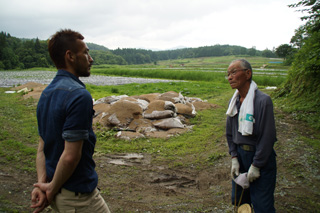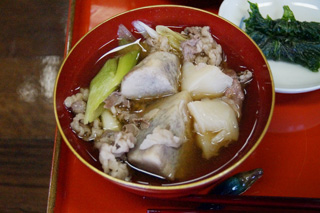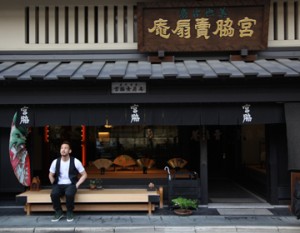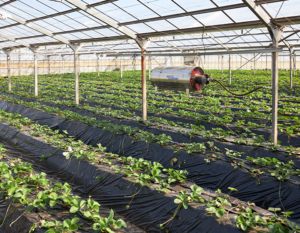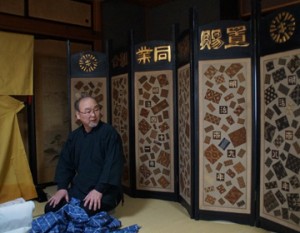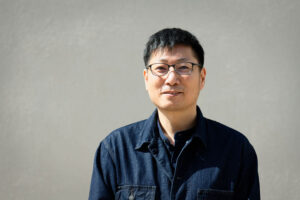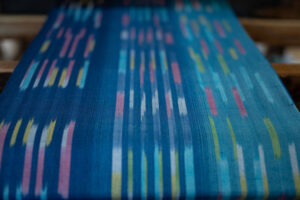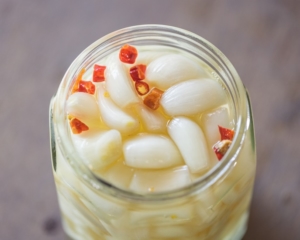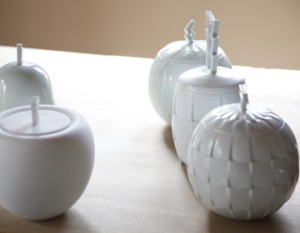The rare“satoimo” passed on to only one child
We met Nobuhide Sato and his grandson Haruki in the mountains by the Sakegawa River, a tributary of Mogami River in northern Yamagata Prefecture. They raise the rare and almost mythical Jingoemon Imo taro. The reason Jingoemon Imo is considered mythical is because Jingoemon Imo is a unique breed, and because they only grow in this soil which is clayish and retains a lot of water.
Nobuhide-san’s brother had once tried growing it in Kanagawa prefecture, but while it grew the first year, it died the next year. Jingoemon Imo is passed on to only one son in the Sato family. Jingoemon Imo is very sticky, and smooth and soft. They are great in the traditional “imoni” (broth-cooked taro) menu, but their tender texture also makes them suitable for western dishes as well. When we asked, “What is your recommended method of cooking?” Sato immediately replied “koromo katsugi” which is steaming with the peel on, removing the peel before eating. According to Sato, that’s the best way, with a little sprinkle of salt.
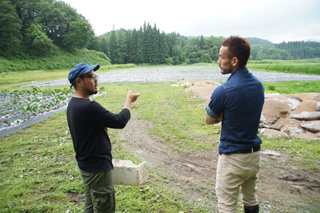
Passed on from parent to child
“Satoimo” is grown by planting seed taro, and the secondary and tertiary cormlets are consumed. From one seed taro, you will get 1 primary, about 6 secondary, and 20 to 30 tertiary cormlets. As the generation progresses, the taro will become more tender. The stalks and leaves on the ground will grow vertically, often as tall as 150 centimeters to the top of the leaf. In our minds we imagine only the “satoimo” growing downwards into the ground, but in fact the field is full of green leaves as tall as a corn field. Normally, you don’t eat the seed taro, but Jingoemon Imo seed taro is edible. It has a different texture from the secondary and tertiary cormlets, but very good when you make croquettes. It was in the Muromachi era when the Satos started growing “satoimo”. The seed potato from that generation or earlier is still in the ground of the Sato family farm. The seed potato has been grown generation after generation every year. This has been going on for 400 years.

Passing on the story
Nobuhide Sato, who is also a storyteller at the Denshokan museum, told us a tale about the Jingoemon Imo. According to the tale, a new lord came to this land 400 years ago. He was kind to the people and watched them work in the fields from spring to autumn. One year the harvest was not good, the old Jingoemon couple was cooking some “satoimo” stew. The lord asked for a bowl of stew for himself and when he tried it, he liked it so much he kept asking for seconds, and there was no stew left for the couple. So the lord gave the couple his lunch box. When they opened his lunch box, expecting to see fancy food, they found only rice mixed with other grains and some leafy vegetables. The peasants, surprised that the lord was eating such a poor diet, became determined not to waste their resources, and thanked the “Jingoemon-Imo” for growing so big in years of poor harvest, pledging to keep growing the “Jingoemon Imo”. Nobuhide-san said the moral of the story was to keep growing the “Jingoemon-Imo”, and also to keep making “miso” paste every year.
“Satoimo” has been a part of the Japanese diet since the Jomon period (14,000–300 BCE), and the Jingoemon-Imo that has been kept alive for 400 years, has a long history and more tales than can be told. Nakata asked Haruki-san about his future goals. “I would like people to know how rich the rural culture is.” There are other traditional vegetables that are grown here. He said that he wants to pass these traditional breeds of vegetables on to later generations. He is also thinking of preserving traditional culture, and holding workshops to learn from the elders.
